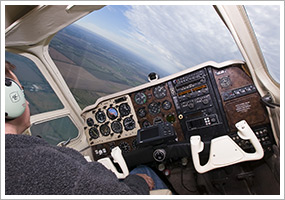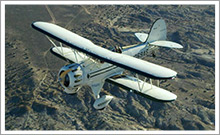Nov. 12, 2010, issue of 'AOPA ePilot: Flight Training Edition' newsletter
| ||||
| | FT News | INSIDE AOPA | TRAINING PRODUCTS | FINAL EXAM | |||
TRAINING TIPsTypes of turns For routine course changes, or turns in the traffic pattern, a medium bank angle will suffice. When practicing minimum controllable airspeed flight, a shallow bank is all you can “afford.” When flying a ground reference maneuver, steepen your bank angle as groundspeed increases. For every in-flight turning situation, there is an appropriate bank angle, or range of bank angles. Medium-banked turns are the normal option in cruise flight. They produce a moderate rate of heading change, and don’t impose high stresses on the airframe. After you enter a moderate-banked turn, you can usually neutralize the ailerons and your trainer remains banked. Steep turns—like those you demonstrate on your flight test—create high load factors because total lift must be significantly increased to turn the airplane (the horizontal component of lift) and keep it at a constant altitude (the vertical component). Unlike moderate bank angles, steep turns are susceptible to the overbanking tendency; aileron pressure must be maintained against the direction of bank to counter overbanking. The aileron deflection requires a touch of opposite rudder to offset drag from the aileron being held down. All that makes the maneuver a usefully intricate skill to learn. Turns made during slow flight also require a fine touch and extremely shallow bank angles, because the high angle of attack of low-airspeed flight leaves little leeway for turning. Understanding this helps an applicant satisfy the private pilot practical test standard for demonstrations of slow flight maneuvers. The pilot must establish and maintain “an airspeed at which any further increase in angle of attack, increase in load factor, or reduction in power, would result in an immediate stall.” You will also learn another type of turn: the standard-rate turn (the two-minute turn) that is used during flight by reference to instruments. Safely shallow, it provides 3 degrees of heading change per second, helping the pilot maintain aircraft control when visual references are lost. Also, “many pilots don’t realize they can escape from an inadvertent cloud entry by simply establishing a standard 3-degree per second turn (a standard-rate turn) and counting 60 seconds,” explains this Air Safety Institute discussion of flight training safety. Learn the right turn for all flight situations. PEAK EXPERIENCE: AOPA AVIATION SUMMIT Flight training summit targets high dropout rate Student pilots drop out of training at a rate that approaches 80 percent—and a lack of educational quality, customer focus, community, and information sharing play a major role in attrition, concluded Mark Benson, chairman of world renowned market research firm APCO Insight. Benson presented findings of an extensive flight training survey at the AOPA Flight Training Summit Nov. 10 in Long Beach, Calif. AOPA, in close coordination with the flight training industry, is working on solutions to stop the major outflow of students. Read more >> iPad cockpit revolutionAs tablet computers—particularly the Apple iPad—become ubiquitous parts of daily life, it’s no surprise to find them changing the general aviation aircraft cockpit. Find out what impact this technology is having on the way we fly in the AOPA Live® segment “The Apple iPad: Cockpit revolution” hosted by Flight Training Deputy Editor Ian J. Twombly Nov. 12 at 12:35 p.m. Pacific Standard Time. Miss the live broadcast? Check back later to see the recorded video. Avidyne Release 9 gets a Frasca simulator At AOPA Aviation Summit, Avidyne Corp. and simulator manufacturer Frasca International announced Nov. 11 that they’ve partnered to create a Cirrus SR22 simulator incorporating Avidyne’s latest Entegra Release 9 (R9) avionics suite. The first such simulator has been delivered to Western Michigan University; a second simulator will be delivered in the near future, Avidyne said. This new flight training device has dual IFD5000 flight displays with dual FMS9000w Flight Management Systems. Made from an actual SR22 cockpit, the training device has Frasca’s TruVision, 220-degree visual display and a Graphical Instruction Station that lets instructors control the training environment. Lesson plans can automatically control the simulator by triggering events based on time, altitude, and other factors. ATP adds six Piper Seminoles to fleet Airline Transport Professionals, a nationwide airline pilot training and pilot career development company, and Piper Aircraft announced Nov. 11 that ATP is buying six Piper Seminoles for its fleet of multiengine training aircraft. Piper will deliver the airplanes before the end of the year. ATP already operates more than 80 Seminoles, in addition to 50 Cessna 172s, five Diamond DA40s, and a CitationJet. “Our fleet purchase will help us meet increasing demand for Mountain State University’s ATP Pilot Operations degree program, for which ATP provides all the flight training,” said Jim Koziarski, ATP vice president of flight operations. The program offers the first aviation bachelor’s degree program with online coursework directly integrated with a standardized flight training curriculum available nationwide, he said. AOPA Live Friday, Nov. 12
YOUR PARTNER IN TRAININGAll AOPA members—including those who have accepted AOPA's six-month introductory membership offer—have free, live access to the association’s in-house flight instructors and aviation experts who are standing by to answer your questions. Call the AOPA Pilot Information Center Monday through Friday, between 8:30 a.m. and 6 p.m. Eastern time, toll-free at 800/872-2672. Check out online Pilot Information Center subject reports. Topics for these reports are drawn from the real-life concerns of AOPA members who call association staff for help about 100,000 times every year. Did you know that student pilots who join AOPA are three times more likely to complete their flight training? Membership includes unlimited access to aviation information by phone (800/USA-AOPA, weekdays from 8:30 a.m. to 6 p.m. Eastern time) or from Flight Training Online or AOPA Online. If you're not already a member, join today and get the pilot's edge. Login information is available online. FLIGHT TRAINING NEWS Student pilots arrested in Mass. flight school investigation Massachusetts authorities have arrested more than 30 flight students and the owner of a flight school and charged them with being in the country illegally, according to reports in the Boston Herald and Boston Globe. The individuals being charged are Brazilian nationals. There were no links to terrorism found in connection with flight training that took place at TJ Aviation Flight Academy at Minute Man Field in Stow. The arrests began in July and concluded last month, the newspapers reported. Fuel facts No one intentionally runs out of fuel in flight. Yet mishaps or accidents caused by improper fuel management do happen. There’s a lot to know about fuel and fuel management. That’s why the Air Safety Institute’s Fuel Awareness Safety Advisor discusses these subjects in detail with the intention to educate you about—and prevent you from becoming a victim of—fuel exhaustion, starvation, and contamination. Stay fuel aware with the Air Safety Institute’s tips included in the advisor. Inside AOPAAOPA, LifeLock partner to protect pilots’ identities More than 11 million Americans suffered identify theft last year. Pilots are at even greater risk—until a few years ago, a pilot’s certificate number was also his or her Social Security number. As the leader in proactive identity theft protection, LifeLock helps to prevent identity theft before it happens. AOPA has worked closely with LifeLock to ensure its services meet the unique needs of a pilot. Special protocols have been created to assist pilots in the event of lost or stolen airman documentation. Read more >> Flying after heart surgery: AOPA member tells his story Don Hull’s heart surgery in April 2009 left him without a medical. Uncertain how to proceed, he joined AOPA’s Medical Services Program and was told that AOPA would help him submit a package to the FAA. “What I submitted was more than 300 pages of my medical record…it was every sheet of paper from the day I went in to the day I was discharged,” he said. Within two months, with the help of the Medical Services Program staff, Hull had his special issuance medical. Read more >> TRAINING PRODUCTSASA releases iBook editions of titlesASA has released iBook editions of several of its titles, including two books written or co-written by Flight Training Contributing Editor Greg Brown. You can download Brown’s Flying Carpet or You Can Fly! (co-authored with Laurel Lippert and Tom Lippert). Also available are the Private Oral Exam Guide and Instrument Oral Exam Guide by Michael D. Hayes, and the Dictionary of Aeronautical Terms by Dale Crane. All are available in the Apple iBookstore, accessed via the iBooks app.
Note: Products listed have not been evaluated by ePilot editors unless otherwise noted. AOPA assumes no responsibility for products or services listed or for claims or actions by manufacturers or vendors. FINAL EXAMQuestion: Can you tell me what the number on the approach end of a runway indicates? For example, my airport has the number 9 on one end and 27 on the other.
Answer: The runway number is determined by its magnetic direction as you approach it, or in Aeronautical Information Manual speak, “The runway number is the whole number nearest one-tenth the magnetic azimuth of the centerline of the runway, measured clockwise from magnetic north.” That means if you are landing on Runway 9, you would be heading east or 90 degrees on the compass. Runway 27, for example, has a magnetic heading of approximately 270 degrees or roughly west, so put your shades on if it is late in the afternoon. Just add a zero to the end of the runway number and you will know what magnetic direction you are heading when you are taking off or landing. For more information on how runways are laid out, see Dave Wilkerson’s article “ Runway Directions.”
Got a question for our technical services staff? E-mail [email protected] or call the Pilot Information Center, 800/872-2672. Don’t forget the online archive of “Final Exam” questions and answers, searchable by keyword or topic. what’s new onlineThe FAA recently published its proposal for modifying pilot working hours, and Chip Wright finds some things to like as well as some details to be leery of in this week’s Flight Training blog. Also, Jill W. Tallman reminds student pilots and flight instructors that cold weather means it’s time to clean the frost off the airplane. Picture Perfect
AVIATION EVENTS & WEATHER To include an event or to search all events in the calendar, visit AOPA Online. For airport details, including FBO fuel prices, see AOPA Airports. Flight Instructor Refresher ClinicsThe next Air Safety Institute Flight Instructor Refresher Clinics are scheduled in Anchorage, Alaska, Atlanta, Ga., and Ashburn, Va., Nov. 20 and 21; Denver, Colo., and Orlando, Fla., Dec. 4 and 5; Northbrook, Ill., Dec. 11 and 12; Long Beach, Calif., and San Antonio, Texas, Jan. 8 and 9. For a complete schedule, see AOPA Online.
Can’t make it in person? Sign up for the CFI Refresher Online. Air Safety Institute Safety SeminarsAir Safety Institute Safety Seminars are scheduled in Costa Mesa, Calif., Nov. 15; Ontario, Calif., Nov. 16; San Diego, Calif., Nov. 17; Warrensburg, Mo., Nov. 18; Marietta, Ga., Nov. 30; Birmingham, Ala., Dec. 1; Pensacola, Fla., Dec. 2; Tampa, Fla., Dec. 7; Lake Worth, Fla., and Timonium, Md., Dec. 8. Topics vary—for details and a complete schedule, see AOPA Online.
| Advertisers Got news? Contact ePilot. Having difficulty using this service? Visit the ePilot Frequently Asked Questions now at AOPA Online or write to [email protected]. | ||||||||||||||||||||||||||
| This issue of ePilot was created for &fname; &lname; at &*TO; Member Tools : Send feedback | Update member profile | Change email address | Unsubscribe | ePilot Archive Editorial Team: ePilot Flight Training Editor : Jill W. Tallman | ePilot Editor: Sarah Brown | Contributor: Alton K. Marsh |

 How much bank will you use for the turn you are about to make?
How much bank will you use for the turn you are about to make?
